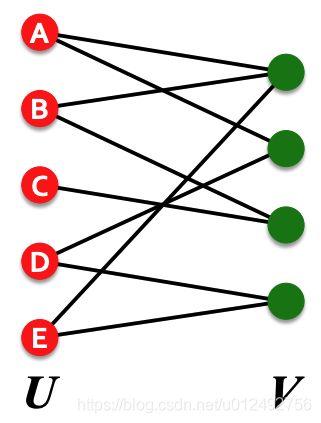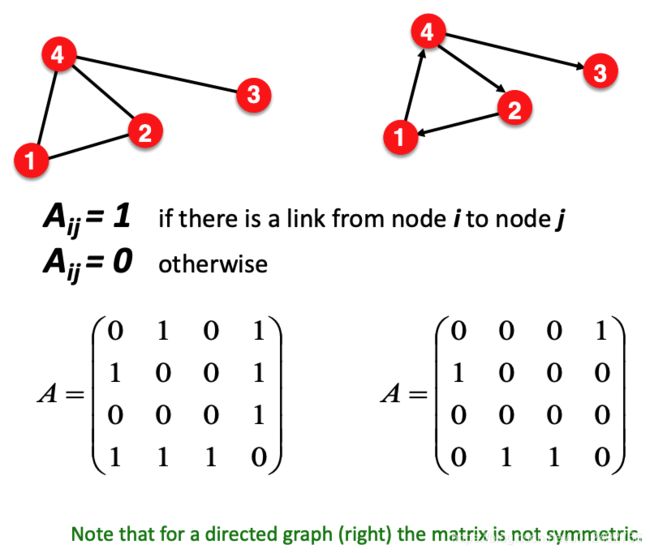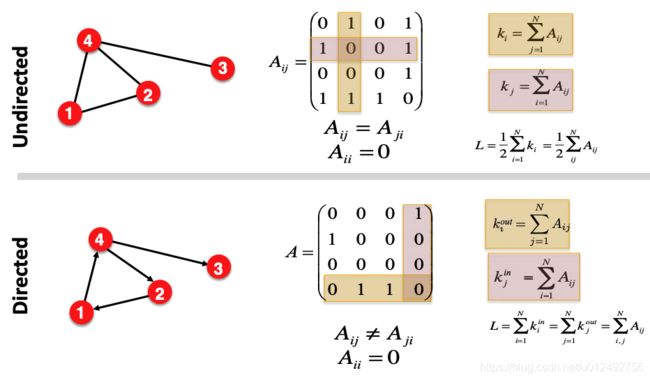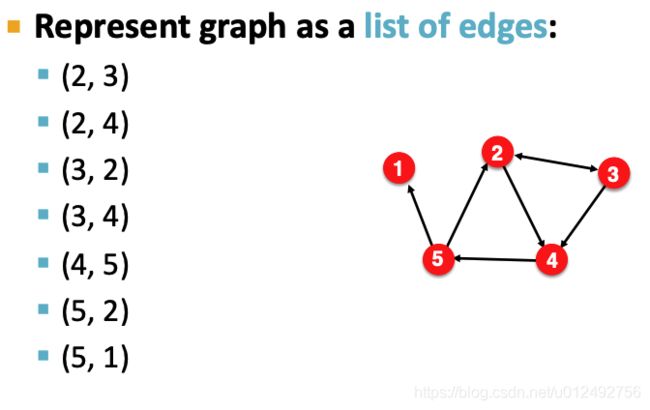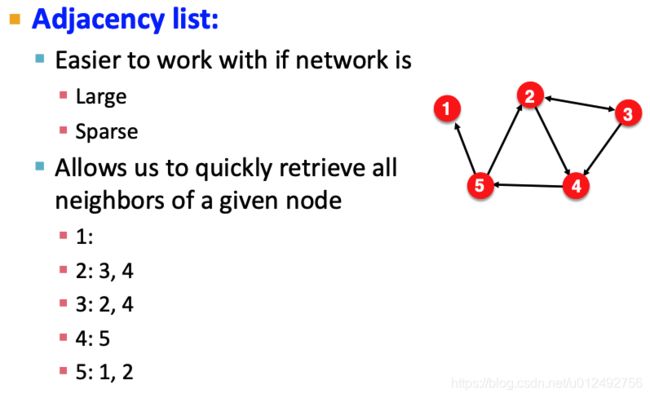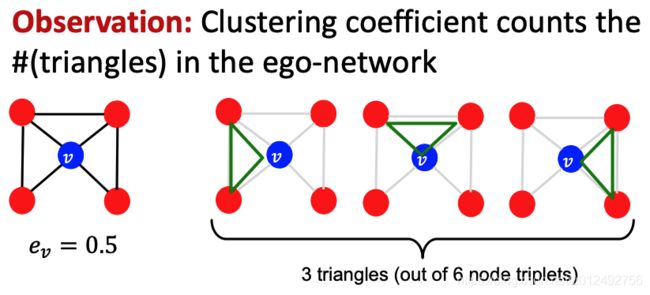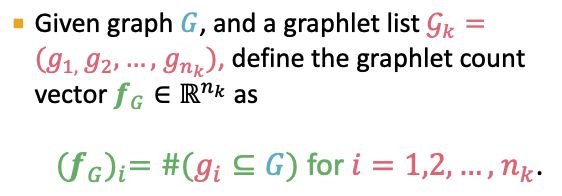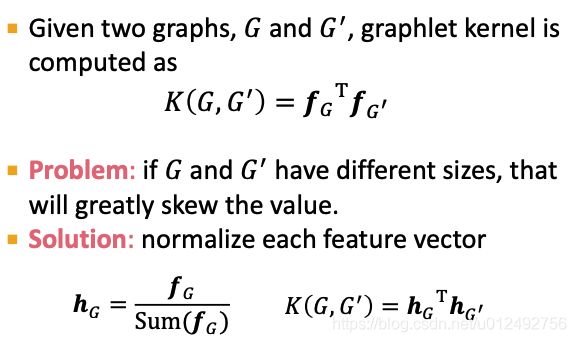GNN-CS224W: 1-2 Introduction; Traditional Methods for machine learning in Graphs
network相比其他的数据有很多特点让它难以处理:
arbitrary size and complex topological structure
Applications of Graph ML
task level
Node-level
Predict a property of a node
Example: Categorize online users / items
Alpha Fold
task: Computationally predict a protein’s 3D structure based solely on its amino acid(氨基酸) sequence
Key idea: “Spatial graph” (represent the underlying protein as a graph)
Nodes: Amino acids in a protein sequence
Edges: Proximity between amino acids (residues) (在空间中接近的node之间构建边)
模型:给定Amino acids的位置及edges proximities between them 然后预测新的Amino acids的位置(还是 Amino acids的新位置),从而最终预测amino acids的位置和protein的最终形态
Edge-level
Predict whether there are missing links between two nodes
Example: Knowledge graph completion
Recommender system
Node: users, items(songs, merchandise…)
Edge: user-item interactions
Goal: recommend items user might like
Drug side effects–Biomedical graph link prediction
有的人可能会吃多种药,目的是预测不同种类的药物同时服用时的副作用
药物太多,导致不可能对所有药物组合试验其副作用,所以采用机器学习来预测
Task: Given a pair of drugs predict adverse side effects
Nodes: Drugs & Proteins
Edges: Interactions between drugs and proteins, Interactions between proteins, Interactions between drugs (drugs之间的interaction代表adverse side effects)
node之间的edge有的是知道的,用模型来预测missing edges
Community (subgraph) level
Detect if nodes form a community(团体)
Example: Social circle detection
相当于cluster,找出社交网络中联系紧密的小团体
Traffic prediction
road network as a graph
Node: Road segments
Edge: connection between road segments
task: 给出从一个node到另一个node的路线
Graph-level
Categorize different graphs
Example: Molecule property prediction
Drug discover
Antibiotics(抗生素) are small molecular graphs
Nodes: Atoms
Edges: Chemical bonds(化学键)
Task: 预测一个分子是否有能被当做药物
原子组合成的分子太多了,无法做到所有的都做药物试验,所以需要机器学习来预测更有可能有用的分子
Graph generation – Drug discovery
还是将原子作为node,化学键作为edges
User case 1: Generate novel molecules with high drug likeness
Use case 2: Optimize existing molecules to have desirable properties (把已有的分子碎片扩展成有特定作用的大分子)
Graph evolution – Physical simulation
Physical simulation as a graph
Nodes: Particles
Edges: Interaction between particles
Task: 预测这些particles将来的状态
Choice of graph representation, how do we define a graph?
the choice of what the nodes are and what the links are are very important.
同样的数据可以选择很多不同的对象作为node和link,node和link的选择对模型效果很重要
Objects: nodes, vertices N
Interactions: links, edges E
System: network, graph G(N,E)
Directed and Undirected Graph
Undirected Graph
node之间的关系是 symmetrical(对称的), reciprocal(相互的)
Examples: Collaborations, Friendship on Facebook
Directed Graph
every link has a direction, a source, a destination
Examples: Phone calls, Following on Twitter
Node degrees
Node degree: k i k_i ki the number of edges adjacent to node i, (包括入度和出度)例如 k i = 4 k_i=4 ki=4
Average degree: 1 N ∑ i = 1 N k i = 2 E N \frac{1}{N}\sum\limits^{N}_{i=1}k_i=\frac{2E}{N} N1i=1∑Nki=N2E
directed graph node has In degree and Out degree
Bipartite graph
- all nodes can be divided into two disjoint(不相交) set U and V
- every link connects a node in U to one in V
- U and V are independent set
Examples:
§ Authors-to-Papers (they authored)
§ Actors-to-Movies (they appeared in)
Folded/Projected Bipartite graph
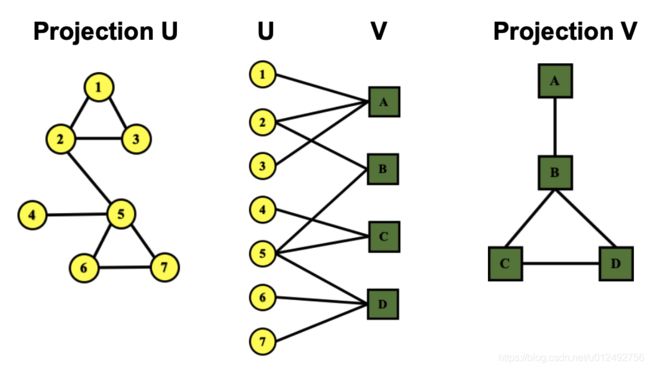
如上图所示,Bipartite graph可以将一边fold起来,fold后graph中的边表示两个node是否可以通过另一边的node连通
假设上图中表示的是author和paper的关系,左边黄点表示author,右边方块便是paper,则根据没有fold的bipartite graph可知,1 2 3三位作者合作了paper A,则1 2 3在fold后的图里是连通的,2和5合作了paper B,则2和5在fold后的图里是连通的。另一边也可以用同样的逻辑fold起来。
Representing graphs
Adjacent matrix
Most real-world networks are sparse, 这导致了 Adjacent matrix 也sparse
例如人们的社交网络,世界上一共有70亿人,但是一个人只能跟很少一部分建立关系,剩余大量的人都没有关系
Edge list
将graph表示为一个二维的matrix
缺点是不能做任何graph manipulation和analysis of the graph
Adjacency list
- 支持 graph manipulation和analysis of the graph
- 相比adjacent matrix存储空间大大减少
可以二维矩阵来存储,因为边很少,所以列数会较小
Node, edge and graph attributes
Possible options:
- Weight (e.g., frequency of communication)
weight可以直接体现在adjacent matrix上 - Ranking (best friend, second best friend…)
- Type (friend, relative, co-worker)
- Sign: Friend vs. Foe, Trust vs. Distrust
- Properties depending on the structure of the rest of the graph: Number of common friends
more types of graphs
- self-edges
节点有从自己出发、指向自己的边,体现在adjacent matrix上就是对角线元素为1 - multigraph
两个节点之间不只有一条边。有时边含义相同,则可以边的数量可以认为是weight;有时边含义不同,不能认为是weight。
连通图和非连通图
Undirected
连通图和非连通图的差别可以提现在adjacent matrix,如下图
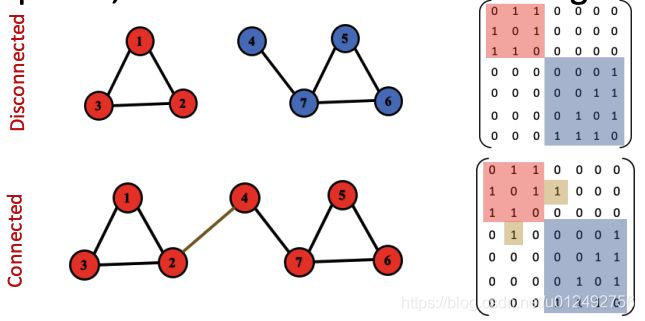
Directed
- Strongly connected directed graph (强连通图)
has a path from each node to every other node and vice versa (e.g., A-B path and B-A path) - Weakly connected directed graph (弱连通图)
is connected if we disregard the edge directions
Strongly connected components (SCCs) (强连通分量)
Traditional Methods for machine learning in Graphs
Traditional ML pipeline
-
Design features for nodes/links/graphs
node feature: 例如 protein attributes
例如node在整个network里处于什么位置,node附近的结构是怎样的特征可以被分为2种:
- network structure
- nodes/links/graphs properties
-
Obtain features for all training data
Node-level tasks and features
Goal: Characterize the structure and position of a node in the network,通常有如下4种特征:
Node degree
Node degree counts the neighboring nodes without capturing their importance.
Node centrality
Node centrality(中心)表示一个node是不是graph的中心,是中心的程度是多少
有如下几种方式
Engienvector(特征向量) centrality
A node v v v is important if surrounded by important neighboring nodes u ∈ N ( v ) u\in N(v) u∈N(v).
node v v v的centrality的计算方式:
c v = 1 λ ∑ u ∈ N ( v ) c u c_v=\frac{1}{\lambda}\sum\limits_{u\in N(v)}c_u cv=λ1u∈N(v)∑cu
其中 λ \lambda λ是一个正的常数,称为eigenvalue(特征值)。上式可以写成matrix form:
λ c = A c \lambda c = Ac λc=Ac
其中A为adjacent matrix, c称为为eigenvector
问题
- The largest eigenvalue λ m a x \lambda_{max} λmax is always positive and unique (by Perron-Frobenius Theorem). The leading eigenvector c m a x c_{max} cmax is used for centrality
- 每个节点的重要性都取决于周围的节点,是否最开始有一些节点被指定了重要性?要不然都依赖于周围,那一步一步往外推,最外层的节点依赖谁?
Betweenness centrality
Intuition: A node is important if it lies on many shortest paths between other nodes
c v = ∑ s ≠ v ≠ t # ( s h o r t e s t p a t h s b e t w e n s a n d t t h a t c o n t a i n v ) # ( s h o r t e s t p a t h s b e t w e e n s a n d t ) c_v=\sum\limits_{s \neq v \neq t} \frac{\#(shortest\quad paths\quad betwen\quad s\quad and\quad t\quad that\quad contain\quad v)}{\#(shortest\quad paths\quad between\quad s\quad and\quad t)} cv=s=v=t∑#(shortestpathsbetweensandt)#(shortestpathsbetwensandtthatcontainv)
"#"表示the number of
Closeness centrality
Intuition: A node is important if it has small shortest path lengths to all other nodes.
c v = 1 ∑ u ≠ v s h o r t e s t p a t h l e n g t h b e t w e e n u a n d v c_v= \frac{1}{\sum\limits_{u \neq v} shortest\quad path\quad length\quad between\quad u\quad and\quad v} cv=u=v∑shortestpathlengthbetweenuandv1
and many others…
Clustering coefficient
Intuition: Measures how connected neighboring nodes are。即一个node的 neighbor 之间的联系是否紧密
e v = # ( e d g e s a m o n g n e i g h b o r i n g n o d e s ) C k v 2 e_v= \frac{\#(edges\ among\ neighboring\ nodes)}{C_{k_v}^2} ev=Ckv2#(edges among neighboring nodes)
其中分子表示node v的neighbor node之间实际的edge数量; k v k_v kv表示node v的degree,分母表示从node v的neighbor node中挑选2个时一共有多少种情况,即node v的neighbor node一共有多少个可能的edge
Another view
Graphlets
we can generalize the above (counting #(trangles) ) by counting #(pre-specified subgraphs, i.e., graphlets).
什么是graphlet
如下图为包括2个到5个node的graphlets
isomorphic(同构)

要注意的是每个graphlet中部分节点被标注了数字,被标数字的node表示当前要得到的是这个node的特征,也就是让该node处于图中的位置的graphlet;数字的大小表示这是第多少种情况,例如3个节点的graphlets一共有2个图,但是有3个graphlet,G2中每个位置都是等价的,所以只有一个graphlet,G1中从位置1和位置2的角度看,G1代表的图是不同的,所以有2个graphlet
Graphlet Degree Vector (GDV)
GDV如下图所示,一个node对应一个向量,向量的每个维度对应一种graphlet,数字表示该graphlet的数量
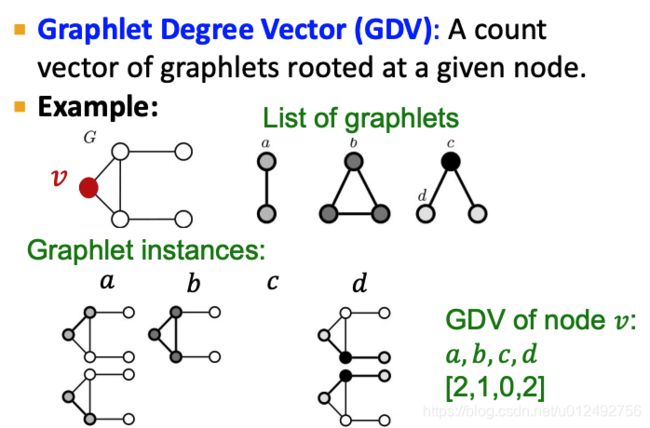
Considering graphlets on 2 to 5 nodes we get: Vector of 73 coordinates is a signature of a node that describes the topology of node’s neighborhood, Captures its interconnectivities out to a distance of 4 hops(5个node的结构需要4条边)
作用
作用:Graphlet degree vector provides a measure of a node’s local network topology
Comparing vectors of two nodes provides a more detailed measure of local topological similarity than node degrees or clustering coefficient.
Node features 分类总结
Importance-based features
capture the importance of a node is in a graph
- Node degree
- Different node centrality measures
Useful for predicting influential nodes in a graph,Example: predicting celebrity(名人) users in a social network
Structure-based features
Capture topological properties of local neighborhood around a node
- Node degree
- Clustering coefficient
- Graphlet count vector
Useful for predicting a particular role a node plays in a graph: Example: Predicting protein functionality in a protein-protein interaction network.
Link-level prediction tasks and features
Task: predict new links based on existing links.
方式:all node pairs (no existing links, 所有以前不存在的link) are ranked, and top k node pairs are predicted
Key: design features for a pair of nodes.
只用node feature的话将会缺少link信息
Two formulations of the link prediction task
Links missing at random:
Remove a random set of links and then aim to predict them
更适合static network,例如protein-protein network
Links over time
这种task假设有一个不断变化的network,例如social network、citation network
Given G [ t 0 , t 0 ′ ] G[t_0,t_0'] G[t0,t0′] (a graph on edges up to time t 0 ′ t_0' t0′, ), output a ranked list L of links (not in G [ t 0 , t 0 ′ ] G[t_0,t_0'] G[t0,t0′]) that are predicted to appear in G [ t 1 , t 1 ′ ] G[t_1,t_1'] G[t1,t1′]
Evaluation 方式:在实际环境中得到 new edges that appear during the test period [t_1,t_1’],和预测的edges做比较
只适用于dynamic network,例如protein-protein network
问题:这里没说清楚 t 0 , t 0 ′ t_0,t_0' t0,t0′的关系, G [ t 0 , t 0 ′ ] G[t_0,t_0'] G[t0,t0′]是一个时间序列及其对应的graph吗?还是只是一个时间点的graph?为什么预测的link不能在 G [ t 0 , t 0 ′ ] G[t_0,t_0'] G[t0,t0′]里?
Methodology 常见步骤
- For each pair of nodes (x,y) compute score c(x,y)
For example, c(x,y) could be the number of common neighbors of x and y - Sort pairs (x,y) by the decreasing score c(x,y)
- Predict top n pairs as new links
- See which of these links actually appear in G [ t 1 , t 1 ′ ] G[t_1,t_1'] G[t1,t1′]
Link-level features
Goal: give two nodes, describe the relationship between them, then predict or learn whether there exists a link between them
Distance-based feature
Local neighborhood overlap feature
Captures number of neighboring nodes shared between two nodes v 1 v_1 v1 and v 2 v_2 v2:

Adamic-Adar index中,如果一个node的degree( k u k_u ku)很大 => log k u \log{k_u} logku较大 => 1 log k u \frac{1}{\log{k_u}} logku1较小
这意味着两个node的共同neighbor中,degree大的发挥的作用小,degree小的发挥的作用大
例如social network中,如果两个人都是同一个明星的粉丝,不意味着两个人之间存在什么关系,但是如果两个人都是一个粉丝数量很少的人的粉丝,则这两个人有关系的可能性更大
缺点:Metric is always zero if the two nodes do not have any neighbors in common.However, the two nodes may still potentially be connected in the future.例如下图所示的情况

这里的local(局部)的意思是只考虑了 v 1 v_1 v1 and v 2 v_2 v2的neighbor,而network里其他的node没有被考虑
Global neighborhood overlap feature
相比Local neighborhood overlap feature,考虑了 the entire graph
一种Global neighborhood overlap feature:
Katz index: count the number of paths of all lengths between a given pair of nodes
Use powers of the graph adjacency matrix to compute the number of paths for a give length between two nodes
powers of the graph adjacency matrix
A ( k ) A^{(k)} A(k)中,k(幂的次数)代表了当前矩阵里的path的length
若 A u v ( k ) ≠ 0 A_{uv}^{(k)} \neq 0 Auv(k)=0,则u和v之间存在长度为k的path,path数量为 A u v ( k ) A_{uv}^{(k)} Auv(k)
现在继续看Katz index
Katz index between v 1 v_1 v1 and v 2 v_2 v2 is calculated as sum over all path lengths
S v 1 v 2 = ∑ l = 1 ∞ β l A v 1 v 2 l S_{v_1 v_2}=\sum\limits_{l=1}^{\infty} \beta^l A^l_{v_1 v_2} Sv1v2=l=1∑∞βlAv1v2l
其中 0 < β < 1 0<\beta<1 0<β<1,为discount factor。式子的意思是 v 1 v_1 v1 and v 2 v_2 v2之间越短的path的权重越大,越远的path的权重越小。 S v 1 v 2 S_{v_1 v_2} Sv1v2越大,表示两个节点联系越紧密。
Katz index matrix is computed in closed-form:
S = ∑ i = 1 ∞ β i A i = ( I − β A ) − 1 − I S=\sum\limits_{i=1}^{\infty} \beta^i A^i=(I-\beta A)^{-1}-I S=i=1∑∞βiAi=(I−βA)−1−I
计算是根据 geometric series of matrices (矩阵的几何级数) 计算得出的, ( I − β A ) − 1 = ∑ i = 0 ∞ β i A i (I-\beta A)^{-1}=\sum\limits_{i=0}^{\infty} \beta^i A^i (I−βA)−1=i=0∑∞βiAi,
Graph-level features and graph kernals
Kernel methods
widely-used for traditional ML for graph-level prediction
Idea: Design kernels instead of feature vectors
普通方法为先对graph提取特征形成特征向量,把特征向量作为模型输入;Kernel methods 也要先对graph提取特征形成特征向量,但是两个graph的特征向量求dot可以直接得到相似度,无需再对特征向量建模
Kernel K ( G , G ′ ) ∈ R K(G, G')\in R K(G,G′)∈R measures similarity between data
Kernal matrix K = ( K ( G , G ′ ) ) G , G ′ \textbf{K}=(K(G, G'))_{G, G'} K=(K(G,G′))G,G′, must always be positive semidefinite (i.e., has positive eigenvals)
There exists a feature representation ϕ ( ⋅ ) \phi(\cdot) ϕ(⋅) such that K ( G , G ′ ) = ϕ ( G ) T ϕ ( G ′ ) K(G, G')=\phi(G)^T\phi(G') K(G,G′)=ϕ(G)Tϕ(G′)
Once the kernel is defined, off-the-shelf ML model, such as kernel SVM, can be used to make predictions.
问题:
- 什么是positive semidefinite matrix(半正定矩阵)?
- 为什么要存在 ϕ ( ⋅ ) \phi(\cdot) ϕ(⋅)?有什么意义?
Graph-level features: Graph kernals
Goal: Design features that characterize the structure of an entire graph to compute similarity
Graph kernal: Key Idea
这里是Graph kernal 方法的一个简单例子
-
特征1:Bag-of-Words (BoW) for a graph
类似表示文本的Bag-of-Words,用一个特征向量表示graph,向量长度为所有graph可能的node总数量,其中每个值表示对应的node在具体一个graph中是否出现
这种方法能包含的信息量非常有限,会让很多结构不同的图得到相同的表示,例如下图

其中 ϕ \phi ϕ表示graph的特征向量 -
特征2:Bag of node degrees
这里的特征1和特征2都是比较初级的Graph kernal方法,下面两个是更高级的方法
Graphlet Kernel
Key idea: Count the number of different graphlets in a graph.
Definition of graphlets here is slightly different from node-level features.
- Nodes in graphlets here do not need to be connected (allows for isolated nodes)
- The graphlets here are not rooted.
其中 S u m ( f G ) Sum(f_G) Sum(fG)表示对特征向量的所有值求和,例如上面例子中 f G = ( 1 , 3 , 6 , 0 ) T f_G=(1,3,6,0)^T fG=(1,3,6,0)T求sum等于10
Limitations
Counting graphlets is expensive!
Weisfeiler-Lehman Kernel
more computing efficient than Graphlet Kernel
Idea: use neighborhood structure to iteratively enrich node vocabulary
实现方法:Color refinement
Color refinement
例子:如下图所示,用1代表初始的color,第一步将node的neighbor都添加到node里,第二步将node和neighbor的组合信息用一个hash 函数映射到另一个color上。这两步就是一次aggregate操作,此时每个节点的颜色包含了node自己的信息以及直接neighbor的信息
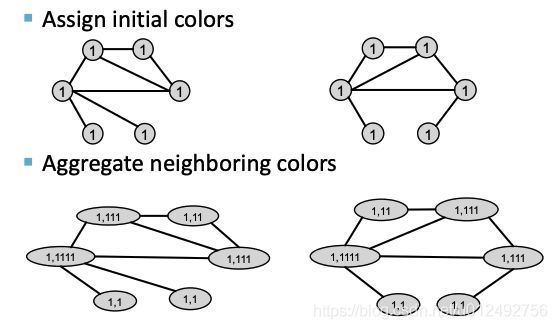

如下图所示进行第二次aggregate操作,对此时的node来说,它已经包括了它的直接neighbor信息,aggregate结束后每个node就包括了距离node 2 步的间接neighbor信息

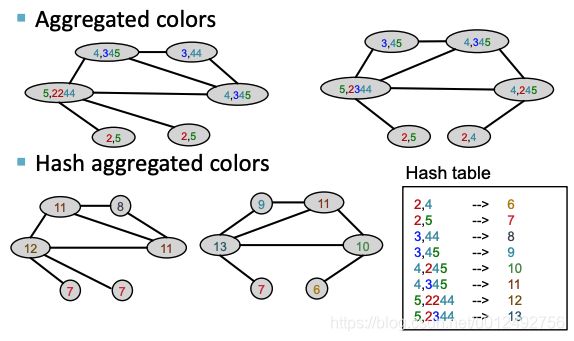
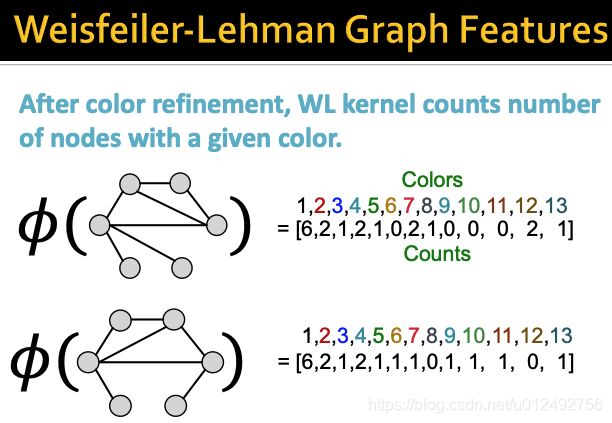
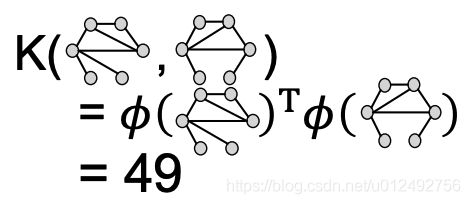
理解
可以有效的集合大量的各种距离的neighbor信息
第一步操作时集合将了距离节点为1的节点的信息,第二步时集合了距离节点为2的节点的信息,第K步后,每个节点就包含所有距离它K的节点的信息
time complexity
- at each step the time complexity is linear in #(edges) (the number of edges)
- #(colors) is at most the total number of nodes
color是可以复用的,只要每一步的color是彼此独立的即可,所以最多只需要节点数量个color - Counting colors takes linear-time w.r.t. #(nodes).
这一步是最后形成feature vector时对每一种颜色计数,只需要#(nodes)次计算
In total, time complexity is linear in #(edges).
Other kernels
(beyond the scope of this lecture)
- Random-walk kernel
- Shortest-path graph kernel
And many more…
